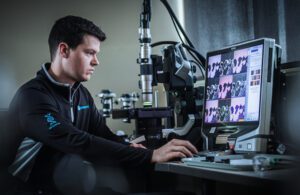
Custom test setups, multi axial loading, or unique wear paths often require complex fixtures and equipment. While there are test standards available (in some but not all cases), designing the test to evaluate a critical feature of your part needs to be considered. [Photo courtesy of Element Materials Technology]
Avoid unexpected failures and keep your project on time and on budget with these best practices.
Eric Kennedy, Kaleidoscope Innovation; and Maciej Jakucki, Element Materials Technology
You’ve passed through your design freeze, parts are rolling in and everyone is excited as verification testing starts.
The first few tests are underway and — uh-oh — your device’s performance is not meeting your requirements. Scrambling to root-cause analysis and rationalizing the poor results leads to no avail. The numbers don’t lie.
You tell the leadership a redesign is needed, timeline is extended, budget is blown, sales forecasts and future company plans are delayed. If only thorough feasibility testing had been conducted, this could have been avoided.
Best practices
A successful testing strategy always begins with the foundation of good acceptance criteria, so at the end of the day we can say objectively how the design is performing. Understand your target throughout the process and answer questions about potential risks during development. Never assume that you won’t have an issue.
Sources for good requirements include: your competition, experience of known performance, failures from the MAUDE database, FDA guidance documents, published literature, risk analysis, test lab consultants, biomechanical data, and human factors/user data.
Next, how is the testing going to be conducted and who is executing it? Does your team have the necessary equipment and experience? Do you need to leverage an external vendor’s expertise?
Digital simulation is a tool that can be used to evaluate several designs, eliminate some options and gain confidence in the part’s performance. To highlight potential problems before they arise, pay attention to boundary conditions, how the design will be held in test fixturing, how it’s clinically used, material properties, and whether a linear or non-linear simulation is needed. To understand how your design will perform, it is important to pay attention to all of regions in the model, not just the highest stress. Watch out — Un-validated simulations are not accepted by regulatory bodies.
Actual force testing may yield valuable learnings on methods that feed into both the design and future validation/verification testing. Using the appropriate force gauge is important to make sure sensor resolution isn’t a large contributor to measured values. In terms of sample size, the goal here is to gain confidence and learn about how the design is failing in an efficient matter. An n (sample size) of three is a minimum that allows some basic metrics to be calculated. ASTM standards usually mandate an n of five; and a sample size of six is often used with FDA submissions.
Worst-case configurations are important to consider evaluating at this stage if your design is marketed in different sizes, footprints, or materials. You want to be sure the rest of the SKUs in your design family will exceed the performance of the test specimen. Additionally, several key factors may also be considered for inclusion in the worst-case definition. At a minimum, estimations of their impact can be added to the uncertainty of your feasibility results. Some of these factors could include sterilization, post-processing, distribution exposure (vibration, temperature, humidity) and shelf-life aging.
Early feasibility testing is conducted on prototype parts that may have looser tolerances, built with non-representative manufacturing processes, and possess other characteristics (like surface finish) that may differ from the final product. Also, crude testing method setups are sometimes employed to save time and get data quickly. It may make sense to come up with a custom methodology to understand the performance of a particular part of the design, as opposed to the whole design. It is important to consider and balance time/cost savings these lower fidelity parts and methods have on data confidence and reliability.

Optical tools can determine defects or voids in materials, coatings, or additive lattices. Identifying and understanding these failure locations or crack initiation sites can improve your R&D decision-making. [Photo courtesy of Element Materials Technology]
Analysis
Tests are in execution. How do we draw sound conclusions? What should we be paying attention to?
In failure analysis, was the observed result what you expected in terms of failure mode and location? Did it match the model side by side?
In addition to the post-mortem images, visual and audible cues during testing can be valuable in determining when conditions in the system are changing. For example, can you tell which strut failed first, and is it consistent part to part?
How did the graph look? Was it textbook force displacement or did it have spikes, and what can those be attributed to? Functional failure/clinical failure is different than an engineering or mechanical failure. Cracks or bending may occur, but this doesn’t mean the device isn’t still doing its job. If there was a mechanical failure, what risks does that create with wear debris or long-term crack propagation?
Test methods are not written in stone, certainly not at this stage. They can be iterated and improved, especially if observations question the clinical relevancy. Test methods also may change entirely. Some devices are known to perform differently in a standardized test material such as foam than they do in actual tissue. Cadaveric testing may be warranted, particularly if a novel device or technique is involved.
Testing may not be a singular event, its often conducted, repeated, and evolved over a long period of time. Banking historical test results/methods into a consolidated location will pay dividends when recall is needed.

Eric Kennedy [Photo courtesy of Kaleidoscope Innovation]
Following some of these guidelines can save your project and company time and money as you evaluate the best way forward for your design. Considerations for feasibility testing should be in your project timeline, especially if you have unique or new design components. There is nothing worse than getting your final parts, only to have an unexpected failure throw the entire project timeline into uncertainty.
Eric Kennedy is a staff engineer at Kaleidoscope Innovation based in Cincinnati, Ohio, and has over 14 years of global medical device experience leading large- and medium-scale concept-to-launch orthopedic, micro-surgical, cardiovascular and ophthalmic devices.

Maciej Jakucki [Photo courtesy of Element Materials Technology]
Maciej Jakucki is a technical director for medical device testing at Element Materials Technology and has 15 years of testing expertise in the orthopedics and cardiovascular industries.
The opinions expressed in this post are the author’s only and do not necessarily reflect those of MedicalDesignandOutsourcing.com or its employees.